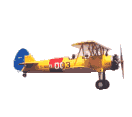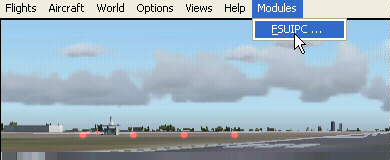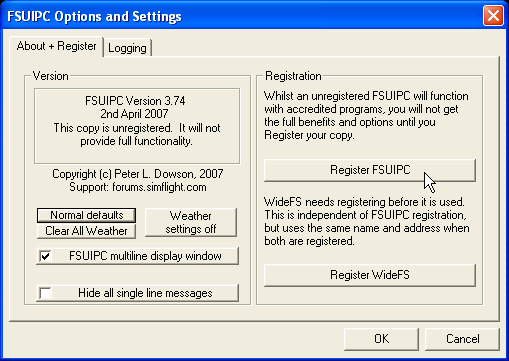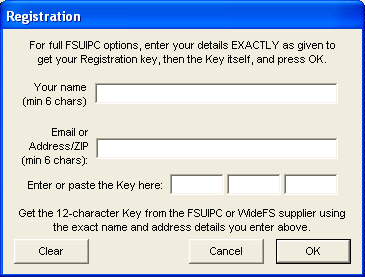 Thank you for your purchase of our Model 2020 Auto Pilot.
The Switch Assignments are involved but can be easily accomplished
with the help of the following information.
Thank you for your purchase of our Model 2020 Auto Pilot.
The Switch Assignments are involved but can be easily accomplished
with the help of the following information.
If you have any
comments or need additional information on the use of the Radio Panel,
please write me
at:
INSTALLATION
Installing the Auto Pilot requires
very little time. All you need is an unused USB Port. Additional Ports can
be added to your computer by using a device called a USB Hub. These Hubs
can be purchased for as little as $20.00 in the
Internet.
Just plus the USB Cable from the
back of the Auto Pilot into the Hub Adapter and let your computer locate
and load the required software for its proper operation. The Auto Pilot
will be sensed as "USB Joystick". That's all there is to the
installation.
Programming the
Buttons and Switches
As mentioned earlier, the 2020 does
require the licensed version of FSUIPC. This small .dll program resided
inside the Module File of your FS2002, FS2004 or FS X Flight
Simulator. FSUIPC come is two versions. The FSUIPC 3.75 used for FS98,
FS2000, FS2002 and FS2004. While Version FSUIPC4 is used strictly for the
New FS X Flight Simulator.
Either one of these programs can be
Downloaded Free of charge from:
The Code Key for either program can
be purchased from simMarket (A link to simMarket is also provided at the
FSUIPC site). The code Key costs about $24.00.
When you download the required FSUIPC
program; copy the .dll program to Flight Simulator's "Module"
File. That's it. Now it's time to load and run your Flight Simulator
Program. When running, click on "Create a Flight". When you have a your
Cessna 172 on the Runway, press the "ALT" key. On the TOP of the screen a
thin white band of extra options will appear. Click on "Modules"; then
"FSUIPC".
Using FSUIPC for the first time, you
are asked to input your Name, Email Address and the Code Key you just
purchased. When entered correctly, FSUIPC is ready to be programmed for
use with your NAV/COM Radio (Note: After inputting your Code Key, you need
to Restart Flight Simulator so that the Code Key can take
effect.
After reloading your Flight
Simulator program; it's time to Program your NAV/COM
Radio.
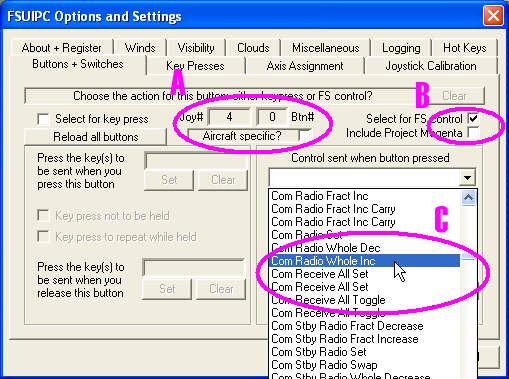
Programming the Auto Pilot
Switches
With your
copy of FSUIPC Registered; now is the time to program the Auto Pilot.
Again, with FS running, hit the "ALT" Key. With the White Band appreaing
in the top of the monitor; click "Modules" then "FSUIPC". With the main
FSUIPC window showing, locate and click on "Buttons +
Switches".
You will
get the window appearing above.
There are three main
sections of this window that require our attention. They are indicated by
the letters "A", "B" and "C". Section "A" shows the Button or Switch that
you press and it's USB Port Location. By pressing other buttons on the
Radio Panel, these settings will change accordingly. "B" needs to be
click. The "Check" Mark needs to remain with ALL Programming. This Check
Mark allows you to choose your button assignments from the FSUIPC listing.
"C" shows all the assignments available that your Radio Panel can be
programmed to.
Now using the TABLE
below, we will program each Auto Pilot Rotary Switch and Push Button
to the needed functions.
Below is a photo of the
front panel of the Auto Pilot. Each Push Button & Rotary Switch is
shown by a number. This number (in conjunction with the information in the
Settings Table) will show you the which button would need to
be "Pushed" or "Turned"
 Auto Pilot Button
Assignments for use with FSUIPC
Auto Pilot Button
Assignments for use with FSUIPC
| * Rotary
Switch (SW #1) |
Rotate Clockwise |
Ap Vs Var Inc or
Ap Vs Var Inc
Fast |
| * Rotary
Switch (SW #1) |
Rotate Counter-Clockwise |
Ap Vs Var Dec or
Ap Vs Var Dec
Fast |
| * Rotary
Switch (SW #2) |
Rotate Clockwise |
Ap Alt Var Inc or
Ap Alt
Var Inc Fast |
| * Rotary
Switch (SW #2) |
Rotate Counter-Clockwise |
Ap Alt Var Dec or
Ap Alt
Var Dec Fast |
| Button #3 Auto Pilot |
Press Button #3 |
Ap Master |
| Button #4 Heading Hold |
Press Button #4 |
Ap Hdg Hold or
AP
Panel Heading On |
| Button #5 Navigate Hold |
Press Button #5 |
Ap Nav1 Hold |
| Button #6 Approach |
Press Button #6 |
Ap Apr Hold |
| Button #7 Reverse |
Press Button #7 |
Ap Bc Hold |
| * Button
#8 Altitute Hold |
Press Button #8 |
Ap Alt Hold or
Ap Panel Altitude
On |
|
|
|
|
* Note: Rotary Switch
#1 settings.
For increments of 100 feet per click,
use "Ap Alt Var Inc"
For increments of 1000 feet use "Ap Alt
Var Inc Fast"
For Deincrements of 100 feet. use
"Ap Alt Var Dec"
For Deincrements of 1000 feet, use "Ap
Alt Var Dec Fast"
========================================================
* Note: Rotary Switch #2
Settings.
For increments of 100 feet per click,
use "Ap Vs Var Inc"
For increments of 1000 feet use "Ap Vs
Var Inc Fast"
For Deincrements of 100 feet. use
"Ap Vs Var Dec"
For Deincrements of 1000 feet, use "Ap
Vs Var Dec Fast"
========================================================
* Note: Push Button #8 "ALT"
Settings. Added 09/21/2007
By programming the
"ALT" Button with "Ap Panel Altitude On";
your Autopilot will operate just as if
you mouse clicked on the ALT
Button on the Autopilot located on the
MS Radio Stack Display.
This setting will allow your Aircraft
to fly to the Selected Altitude (SW #2) via the
Autopilot at a Vs of your choosing (SW
#1 - Ex. 700ft per minute); then level
off at this altitude and
maintain level flight.
========================================================
* Note: Push Button #4 "HDG"
Settings. Added 10/20/2007
By programming the
"HDG" Button with "Ap Panel Heading On";
your Autopilot will operate just as if
you mouse clicked on the HDG
Button on the Autopilot located on the
MS Radio Stack Display.
This setting will allow your Aircraft
to make easy turns either left or right;
then level off at this heading and maintain level
flight.
This setting will also prevent the "snap" action of the Heading
"BUG" to the top
of the Guage.
I'll take you
through the first two programming procedures so you can familiarize
yourself with the operation.
The Table above shows that Button #1
is the "Vertical Speed" Rotary Switch on the Panel. The center column
shows that Switch #1 is to be "Pressed". The third column shows the
function we will program the switch with using
FSUIPC.
So with your Auto Pilot Plugged into
the USB Port and FS running and showing the FSUIPC window, turn Switch #1
"Clockwise". Notice "A" on the "FSUIPC Options and Settings" Window,
it will indicate a USB Port Value and Switch Location. Now make sure
that at "B", you have checked "Select for FS Control". Now click on
"Control Sent when Button is Pressed" ("C"). Using your mouse, run down
the list and find "Ap Vs Var Inc" and highlight this setting. That's it.
(If you make a mistake; just click on "CLEAR".
Lets goto the next button.
Now we'll turn the #1 Rotary Switch
"Counter Click-wise". Note at "A" there is a new Port Number and Switch
displayed. "C" shows a blank window at this time. Again, using your mouse,
click and find in the listing of FS Settings; "Ap Vs Var
Dec".
Continue the programming process for
the remaining switches.
Using your Auto
Pilot
With all your switches programmed as shown above;
press the "OK" icon. All settings will be saved inside your FS files. And
the FSUIPC window will disappear.
With your version of Flight Simulator running, you
must firat display the "Radio Stack" on the monitor. This can be done by
clicking on the Radio Antenna Icon on the screen or if you purchased our
NAV/COM
Radio Panel, all you need to do is to press the "Display"
Button.
Altitude Hold
- With the Radio Stack displayed, lets say we wish to fly our airplane at
an altitude of 2000 feet via the Auto Pilot. To do this, all we need to do
it to rotate the Rotary Switch Clock-wise (Altitude Hold) until 2000
is seen on the monitor's Radio Stack. To activate the Auto Pilot, just
press the "ALT" Button. Your aircraft will now fly at an altitude of
2000 feet. To de-activate the Auto Pilot, just press the "AP"
button.
Vertical Speed
- This button is used in conjunction with the "Altitude Hold". Vertical
speed is the number of feet UP or Down you wish to travel to obtain
the desired Altitude. Say you wish "Flight Level" altutude of 2000 feet
AGL (Above Ground Level). Your present altitude is 1000 feet. You can use
your Auto Pilot to ascend to 2000 feet by first turning the "Altitude
Hold" Rotary Selector Switch (Switch #2) Clock-wise until 2000 is
displayed on the Radio Stack. Then adjust the "Vertical Speed" Selector
Switch Click-wise until it reads +500. Then press the "AP" Button. This
setting tells the Auto Pilot to ascend to a final altitude of 2000 feet
but at a rate of 500 feet per minute. Using simple math, you can determine
that it will take 2 minutes for your aircraft to reach the altitude of
2000 feet.
When reached, the "Vertical Speed" indicator
will read "000", thus allowing the plane to level-off at 2000
feet.
Conversly, if you wish to decend to 1000 feet from
your flight level altitude of 2000 feet, you can turn the "Vertical Speed"
Rotary Selector Switch (Switch #1) Counter Clock-wise
until the Radio Stack readout indicates -500 Feet. When you activate the
Auto Pilot, your plane will decend at a rate of 500 feet per minute until
the desired altitude of 1000 is reached.
Note that Engine RPM is also a factor when
ascending and decending even when using the Auto Pilot.
Heading Hold -
To HOLD the Heading your aircraft is flying at the present time, just
press the "HDG" Button on the Autopilot. If you wish to change your
heading while the Autopilot is activated, just turn the Compass
Gauge's "HDG" Setting Knob until the "Heading BUG" indicates the new
heading. While adjusting the new Heading, the Autopilot will
start "banking" to this new direction. When the "Heading BUG" is
centered at the top of your Compass Gauge, the Auto Pilot will
bring "wings-level" flight back to your aircraft at the selected
Heading. If you re-adjust the "Heading Bug" to a new heading while the
Auto Pilot in engaged, your airplane will again bank to the desired
heading. To disengage the "Heading Hold", you can press the "HDG" Button
again or press the "AP" Button.
This is just a small sample of what your Auto
Pilot can do. For more information on using the Auto Pilot features for
your version of your Flight Simulator, you can goto the "Instructional"
Page of the Flight Sim Program.
Please note that FSUIPC places a 1/4 second delay
between pressing a button and seeing results on your Monitor. So rotating
SW #1 and SW #2 F A S T will have
NO Effect on the digital display. Slow rotation of the Rotary Switch is
more desirable then speeding through the dial. Besides, racing through the
settings will shorten the life of the rotary
switches.A
Purchasing Information can be
found HERE;

hit counters
| 

